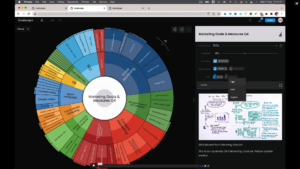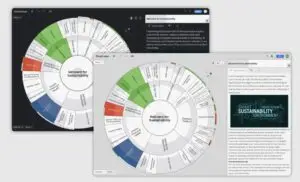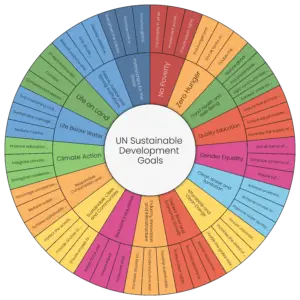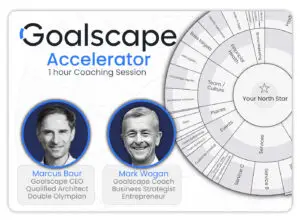Managing teams with Objectives and Key results (OKRs) has become really popular all over the world, especially since Google’s stellar ascent, which has been attributed partly to Google adopting the OKR process in its early startup days. The ideas behind it go back more than 70 years though, and at its core, it’s just a way to manage white collar work, that cannot and should not be managed through top-down commands and repetitive routines.
The simplicity of the process is what made it so successful. In its essence, it’s a great way to apply helpful disciplines, and a good way to introduce, manage and evolve new goals. The key OKR Lingo and the corresponding elements in Goalscape are:
Objectives: Big Fuzzy Goals
These are goals that can be somewhat general and fuzzy. But it’s good to have those as they can serve as motivating ‘north stars’: they inspire people and give them direction. The number of such goals depends on the main goal (at the center of the Goalscape goal map); to maintain focus there should be no more than 10. Objectives are positioned at Level 1 of the goal map.
Key Results: Smaller Concrete Goals
These are much more specific goals that can be qualified and quantified accurately. They are typically positioned at Level 2 of the goalscape goal map; they do not have to be direct subgoals of the somewhat fuzzy Objectives though. If you have subgoals of increasing specificity, that may not qualify as key results, you can slot them into your goalscape in between the Objectives and Key Results, which themselves could end up on level 3 or 4 (or even lower). This makes Goalscape much more flexible compared to other solutions.
Differentiate between Committed and Aspirational Goals
There is a big difference between committed and aspirational goals. Committed Goals are goals that must be achieved just to keep a project (or the whole business) up and running and alive. Aspirational goals on the other hand, are goals that may create new opportunities, yet nothing really bad happens if they are not achieved. Its a very useful distinction to make when you prioritize your goals. It is also worth tagging them with a “Committed” or “Aspirational” Tag (or similar).
Timeboxing
This is a crucial element of the OKR process. It’s popular to break down the year into 4 quarters. Any time period works though. We currently favor quarterly plans over annual plans because a time horizon of a few weeks is more gratifying and allows for more flexibility in adapting the plan. In more settled businesses, annual plans may be more fitting. More fine-grained timeboxes can simply be defined in Goalscape using Due Dates. It is essential to update your progress frequently – at least once a week.
Confidence (to achieve a key result/goal)
Asking people how confident they are about achieving a goal, in a given Timebox, is a very efficient way for a team to understand what’s going on. By contrast, when we ask people “how are things going?”, we are likely to be inundated with detailed descriptions of everything that person is doing. And a million words might not be enough to reflect the current reality faithfully! These details though only matter if things go sour and there is something that can be done about it. So in goal setting sessions and periodic reviews, we ask for a confidence estimate, using numbers between 0 and 10 (10 being ‘absolute confidence’ and 0 being ‘it’s impossible’. This keeps the interactions short and to the point.
In initial Quarterly planning, committed goals should be on the high end of the confidence scale, while aspirational goals can be fairly low. A mid-range confidence can be considered a good start for something ambitious. The confidence should be updated every week. In the third month of the quarter, mid range values should be avoided. It should be clear if goals are in the green zone (likely to be achieved) or the red zone (unlikely). Then for any goal in the red zone you can decide whether to throw more resources at it or park or delete that goal and spend the effort elsewhere.
So the range looks like this:
Low 0 1 2 3 4 5 6 7 8 9 10 High
This can also be done if a trend establishes through the weekly updates. We simply note down the trend in the top of the Notes field (at least on the committed goals) like this:
Confidence: 5 > 6 > 7 > 7 > 9
In this example, the trend over the first 5 weeks of the quarter is positive and all is looking good. In the following example, the goal would require some extra attention
Confidence: 5 > 6 > 4 > 2
Focus
Never before has humanity been as easily distracted as today. We can lament that, or we can appreciate this fact as an opportunity to generate competitive advantages. Being able to decide what to do now (and what not) is becoming one of the key success skills of our time. Our team always tries to invest enough time to carefully decide what to do NOW and what to do NEXT and Tag goals accordingly. Once NOW goals are achieved, the priorities of the NEXT goals are re-evaluated and one (to max three) NOW goals are selected.
The Goalscape Focus-Filter (top right) makes it really easy to filter for NOW and NEXT goals per person and to view and export a corresponding List of these goals.
Summary
The basic setup of OKR´s in Goalscape is really simple:
- Define Objectives and Key Results in Goalscape. Optionally tag goals as “Committed” (must achieve) or “Aspirational (want to achieve).
- Assign who owns which goal (Responsibles)
- Set your relative importances (priorities of the goals) for the quarter.
- Tag Goals (Key Results and Tasks) as “NOW” or “NEXT” and Focus on them via the Focus panel (top left)
- Update Progress and Confidence weekly
- Frequently Review: celebrate successes, run retrospectives and plan for the next quarter (or other period).
Schematically it looks like this:

This is an example of a Marketing OKR goalscape:

To learn more about the OKR process and terminology, and to download the chart, read our Blog article on the topic here.



